- General Information
- 0 Metadata
- 1 Identification Information
- 2 Data Quality Information
- 3 Spatial Data Organization Information
- 4 Spatial Reference Information
- 5 Entity and Attribute Information
- 6 Distribution Information
- 7 Metadata Reference Information
- 8 Citation Information
- 9 Time Period Information
- 10 Contact Information
The Federal Geographic Data Committee's (FGDC) Content Standard for Digital Spatial Metadata(CSDGM) is a well-known metadata standard that has been used in North America and around the world for many years. This is the type of metadata created by default with ArcGIS Desktop 9.3.1.
You can create complete FGDC metadata content in the current version of ArcGIS for Desktop in the pestaña Descripción when you use the FGDC CSDGM Metadata style. This guide clearly illustrates where to put the information associated with each FGDC metadata element. Some metadata elements are organized and named differently in the ArcGIS metadata editor than in the FGDC metadata standard. However, when you export metadata from ArcGIS to the FGDC XML format, all ArcGIS metadata content associated with the CSDGM standard is extracted and arranged correctly to create a complete FGDC-formatted metadata XML file that can be validated using either the metadata parser utility, known as mp, or the FGDC XML schemas.
The FGDC CSDGM standard is divided into seven main sections. This topic is split into sections that correspond with the standard. Production rules for each metadata section are provided in tables. Screen captures following each table show where to put an element's content in the ArcGIS metadata editor. Additional tables contain the production rules for each compound metadata element. If information is required to explain what to type or how ArcGIS handles an element's content, it will be provided in a paragraph that immediately precedes the associated screen capture.
FGDC metadata includes three reusable sections of information: Citation Information, Time Period Information, and Contact Information. Separate sections in this topic illustrate how to provide their content. In the seven main metadata sections, if an element references a reusable section, the screen capture will only show how to add that section, for example, a contact. Refer to the reusable section's detailed instructions for more information. The exception is the citation that describes the item itself, where some content is handled differently than for other resources that may be cited in the metadata.
Section zero in the CSDGM provides production rules for the seven metadata sections themselves, indicating which sections are mandatory. This section is presented first in the topic below. It provides links that can quickly take you to the detailed information for each metadata section further down in this topic.
Some information, such as an item's detailed spatial reference properties, can only be added to an item's metadata by the metadata synchronization process. To include this information in an item's metadata, automatic updates must be turned on in the Options dialog box. The only way to change the properties of an item that are recorded in its metadata is to change the item's data or settings in ArcGIS. The next time the item's metadata is synchronized after the item has been updated, its current properties will be updated accordingly in its metadata. The screen captures may illustrate where to find the item's properties in the metadata display, so you can check that this information has been recorded by the synchronization process.
General Information
The following information applies to all FGDC metadata content that is edited, upgraded, and imported in ArcGIS.
Dates and times
In ArcGIS metadata, all dates must be valid dates that consist of a year, a month, and a day. To enter this information in the pestaña Descripción, click the calendar control and click the appropriate date. Times in ArcGIS metadata must be valid, and must include hours, minutes, and seconds. To enter this information, click the portion of the time you want to change and type in the appropriate value. The up and down arrows can only be used to change the hour. For more details about using the calendar and time controls, see the Time Period Information section.
If an item's existing FGDC metadata contains a date that is only a year, when this metadata is upgraded or imported into ArcGIS the date is converted to the first of January in that year. If the original date consists of a year and a month, this date is converted to the first day of that month in the specified year when the metadata is imported or upgraded. If the original value provided is a string, such as Spring 2003, this information can't be converted to a date; the value won't be imported or upgraded. Similarly, if the original date is invalid, for example, because the date didn't adhere to the FGDC yyyymmdd format, the date won't be imported or upgraded.
When describing an item's time period, provide a date range that runs from the first day to the last day of the appropriate year or month instead of providing a partial date. Instead of specifying spring in a given year, specify a range of months during which the data was collected or the map was created.
If the original metadata includes only a partial time, zero seconds, minutes, or hours will be added as appropriate. If the original time provided is a string, such as 2 a.m., this information can't be converted to a time; the value won't be imported or upgraded. Times can't be provided in ArcGIS metadata without an accompanying date.
In FGDC metadata, some elements that typically require dates or times may allow text, such as unknown, unpublished material, or now. This information will be upgraded or imported to ArcGIS metadata. However, at present, imprecise dates and times such as these can't be edited in the pestaña Descripción. If more detailed dates and times are specified in the item's ArcGIS metadata, they will be used in place of the imprecise values when ArcGIS metadata is exported. Otherwise, the original imprecise dates and times will be exported to the FGDC format.
Specifying None for mandatory elements
In FGDC metadata, it is common practice to include the text None in mandatory elements where the information associated with that element is either unknown or inapplicable. For example, whenever keywords are provided, a thesaurus must be specified even if one wasn't used. The same practice is used if there are no access and use constraints associated with the item, because these metadata elements are mandatory.
When an item's existing FGDC metadata is upgraded or imported to ArcGIS, the value None isn't included in the item's ArcGIS metadata. Do not add any thesaurus citation information in ArcGIS metadata if a set of keywords wasn't selected from a thesaurus. Do not add any constraint information if there are no constraints to report. When metadata is exported to an FGDC-formatted XML file, the exporter will automatically add in these elements with the value None.
Values are handled as coded lists
In FGDC metadata, many elements have a domain where the value can be one of a specified set of values or any other text. As a result, people often write different phrases that express the same meaning in the same metadata element. The equivalent metadata elements in the ISO metadata standards are typically associated with codelists. A codelist is a set of codes that communicate a specific concept unambiguously; free text is not supported. The ISO metadata standards include codes that articulate many of the same concepts that are defined in the FGDC CSDGM standard. In some cases, the North American Profile added codes to these codelists to include FGDC CSDGM concepts that were missing in the base standard.
The associated ArcGIS metadata elements use codelists. When an item's existing FGDC metadata is upgraded or imported to ArcGIS, the word or phrase provided in the FGDC metadata element is converted to a coded value. The phrases defined in the FGDC CSDGM standard and some well-known variations of them will be successfully matched to the appropriate code. North American Profile codes are used in cases where the base ISO metadata standard codes are insufficient.
If one of the phrases suggested in the FGDC CSDGM standard is misspelled, or if an alternate phrase was used, the upgrade process is unlikely to recognize it even though it has the same meaning. In this case, ArcGIS will be unable to assign the appropriate code that corresponds to the original value. Be sure to check an item's upgraded or imported metadata. If any values were not successfully matched, pick the appropriate code from the codelist and save your changes.
Reordering of repeating elements
An element is said to be repeating if many of those elements occur in the item's metadata. For example, many keywords are allowed. Each keyword is stored in a separate keyword element—the element repeats once for each keyword that has been provided. From an XML perspective, repeating elements are not required to be maintained in a specific order.
XML elements can be processed in different ways. Some of them maintain document order; that is, elements are always handled sequentially. If XML elements are always handled in document order it can appear as if the order of repeating elements is being maintained even if this is not technically true. Other processing methods handle XML elements in random order.
When an item's existing FGDC metadata is upgraded or imported, metadata elements are processed randomly. As a result, you may find that after upgrading or importing FGDC metadata to ArcGIS, repeating elements such as keywords may not occur in the same order as in the original FGDC-formatted metadata document. This is a one-time change that may occur during the import or upgrade process. While this change might be visually disconcerting, the metadata is not invalid just because the XML elements were rearranged.
0 Metadata
| 1.0 | |
| 2.0 | 0{Data Quality Information}1 + |
| 3.0 | |
| 4.0 | |
| 5.0 | |
| 6.0 | 0{Distribution Information}1 + |
| 7.0 |
Reusable sections
1 Identification Information
| 1.1 | Citation + |
| 1.2 | Description + |
| 1.3 | Time Period of Content + |
| 1.4 | Status + |
| 1.5 | Spatial Domain + |
| 1.6 | Keywords + |
| 1.7 | Access Constraints + |
| 1.8 | Use Constraints + |
| 1.9 | (Point of Contact) + |
| 1.10 | (1{Browse Graphic}n) + |
| 1.11 | (Data Set Credit) + |
| 1.12 | (Security Information) + |
| 1.13 | (Native Data Set Environment) + |
| 1.14 | (1{Cross Reference}n) |
Both the Use Constraints and Data Set Credit elements can be edited on more than one page. Use Constraints can be edited on both the Overview > Item Description page and the Resource > Constraints page. Credits can be edited on both the Overview > Item Description page and the Resource > Details page.

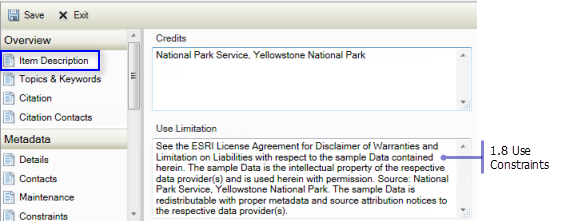


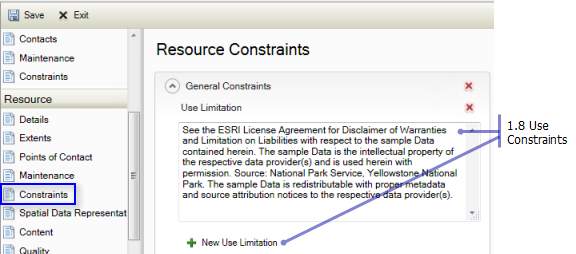


1.1 Citation
For the item's citation only, the citation title can be edited in two locations, on both the Overview > Item Description page and the Overview > Citation page.
When existing FGDC-formatted metadata is upgraded, the original title for the item is replaced by the item's name in ArcGIS. This is a known issue with metadata synchronization. A workaround is to copy the original FGDC title under the FGDC Metadata (read-only) heading in the metadata display by highlighting text and pressing CTRL-C. Start editing the item's metadata, then paste it into the title element in the ArcGIS metadata editor.

For the item's citation only, the FGDC CSDGM Geospatial Data Presentation Form element is associated with four separate ArcGIS metadata elements. The Presentation Form element on the Overview > Citation page offers a good overall categorization of the type of information provided by the item. The type of digital spatial data is described using the Spatial Representation Type element on the Resource > Details page, if appropriate. The type of data contained by a raster is further described using the Content Type element on the Resource > Content page.
When existing FGDC-formatted metadata is upgraded or imported, the original Geospatial Data Presentation Form value is kept in the ArcGIS Metadata element FGDC Geospatial Data Presentation Form. For new ArcGIS metadata you can also select a value from the FGDC CSDGM Geospatial Data Presentation Form domain using this element on the Overview > Citation page. This element's domain might let you describe different types of hard-copy maps better than the codelists used by the other ArcGIS metadata elements. Setting a value in this ArcGIS element doesn't alter any FGDC-formatted content that may also exist in the item's metadata.
When ArcGIS metadata is exported to an FGDC-format XML file, all four of these elements are considered when determining the most appropriate value to place in the Geospatial Data Presentation Form element.
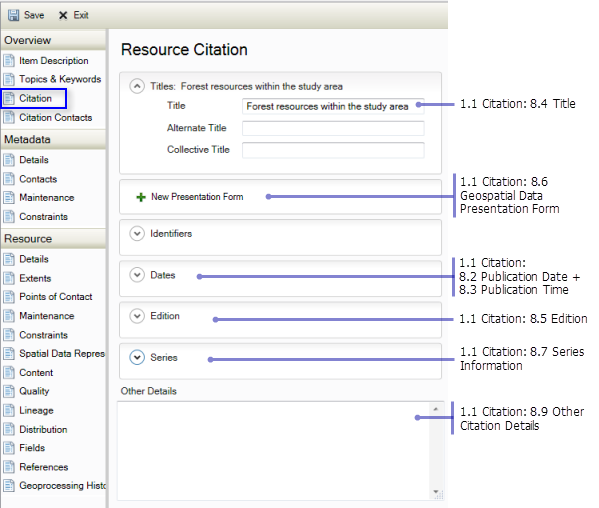
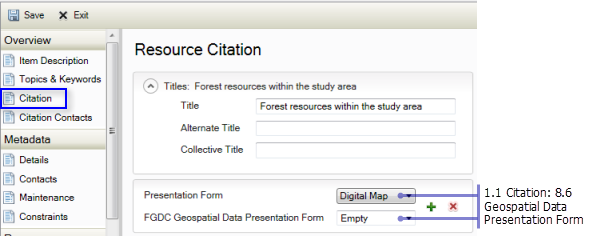
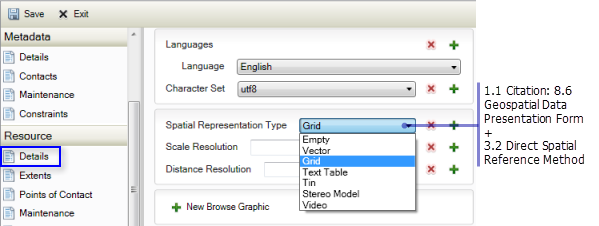

An FGDC citation must include an originator, and a publisher may also be provided. In ArcGIS metadata, these are contacts associated with the citation. The contact's role lets you identify how they are associated with the resource. For the item's citation only, these contacts are provided on the Overview > Citation Contacts page. Use the contact role originator or publisher, as appropriate.

For the item's citation only, provide an online linkage by entering an appropriate network or Internet location under the Digital Transfer Options heading at the top level of the Resource > Distribution page. When metadata is exported to an FGDC-format XML file, this information will not be included in the Distribution Information section as a Network Resource Name.


Citations for related resources are provided on the Resource > References page; they are referred to as aggregate resources. You must specify the type of association that exists between the item and the other resource. If you want to provide a Larger Work Citation for the item, select that as the Association Type.
In ArcGIS metadata, a Larger Work Citations can only be provided for the item itself. For resources that are cited elsewhere in an item's metadata, such as sources or cross-referenced citations, only brief citations can be provided. You can learn more about these other resources, such as the larger works with which they are associated, by locating and reading the other item's metadata.

1.2 Description
| 1.2.1 | Abstract + |
| 1.2.2 | Purpose + |
| 1.2.3 | (Supplemental Information) |
Formatting may be used to enhance the appearance of descriptions that will be published to ArcGIS Online. However, this formatting is removed when content is exported to any standard-compliant metadata format.


1.3 Time Period of Content
| 1.3.1 | Currentness Reference |


1.4 Status
| 1.4.1 | Progress + |
| 1.4.2 | Maintenance and Update Frequency |
When an item's existing FGDC metadata is upgraded or imported to ArcGIS, the phrases provided in the Progress element and the Maintenance and Update Frequency element are both converted to coded values. Check the values of the Status element on the Resource > Details page and the Update Frequency element on the Resource > Maintenance page to make sure their values were set appropriately.


1.5 Spatial Domain
| 1.5.1 | Bounding Coordinates + |
| 1.5.2 | (1{Data Set G-Polygon}n) |


1.5.1 Bounding Coordinates
| 1.5.1.1 | West Bounding Coordinate + |
| 1.5.1.2 | East Bounding Coordinate + |
| 1.5.1.3 | North Bounding Coordinate + |
| 1.5.1.4 | South Bounding Coordinate |

1.5.2 Data Set G-Polygon
| 1.5.2.1 | Data Set G-Polygon Outer G-Ring + |
| 1.5.2.2 | 0{Data Set G-Polygon Exclusion G-Ring}n |
It is not possible to define a bounding polygon for an item in the pestaña Descripción using this version of ArcGIS. However, if your existing FGDC metadata contains this information it will be upgraded and stored in the ArcGIS metadata format. It will be displayed along with the rest of the item's metadata and exported to FGDC-format XML files with the rest of the item's metadata content.
1.6 Keywords
| 1.6.1 | 1{Theme}n + |
| 1.6.2 | 0{Place}n + |
| 1.6.3 | 0{Stratum}n + |
| 1.6.4 | 0{Temporal}n |
All keywords are defined in the same manner. Type each keyword on a separate line. A keyword can be a phrase, and punctuation can be used, if appropriate. If keywords were not derived from a thesaurus, don't provide any information under the Thesaurus Citation heading. When ArcGIS metadata is exported to an FGDC-format XML file, a Thesaurus element with the value None will be added automatically if a Thesaurus Citation Title wasn't provided because this information is required by the FGDC CSDGM.

1.6.1 Theme
| 1.6.1.1 | Theme Keyword Thesaurus + |
| 1.6.1.2 | 1{Theme Keyword}n |

In preparation for supporting international metadata standards, the FGDC has recommended collecting ISO 19115 topic category information in FGDC metadata as theme keywords using the thesaurus name ISO 19115 Topic Category. When existing metadata is upgraded, if a theme keyword section is found with this thesaurus name, those keywords will be imported as topic categories; otherwise, all keywords will be examined to see if any correspond with a topic category. When ArcGIS metadata is exported to an FGDC-format XML file, any topic categories provided on the Overview > Topics & Keywords page are included in the exported content as a separate set of theme keywords with the thesaurus name ISO 19115 Topic Category.

The Tags that may be provided on the Overview > Item Description page are intended to support searching in ArcGIS. Tags are an unrestricted, comma-separated list of words that are maintained separately from formal keywords; a thesaurus can't be provided as a reference for a set of tags. This lets you use internal terms or project names for searching in ArcGIS without compromising standard-compliant metadata content that must be published and shared with an external audience. Of course, any internal tags should be removed if the item itself is published along with its metadata, for example, if it is shared using ArcGIS Online.
If formal keywords have been provided, tags won't be exported to any standard metadata format. However, if formal keywords have not been provided and a list of tags is available, those tags will be exported as Theme Keywords. The Thesaurus will be identified as None.

1.6.2 Place
| 1.6.2.1 | Place Keyword Thesaurus + |
| 1.6.2.2 | 1{Place Keyword}n |

1.6.3 Stratum
| 1.6.3.1 | Stratum Keyword Thesaurus + |
| 1.6.3.2 | 1{Stratum Keyword}n |
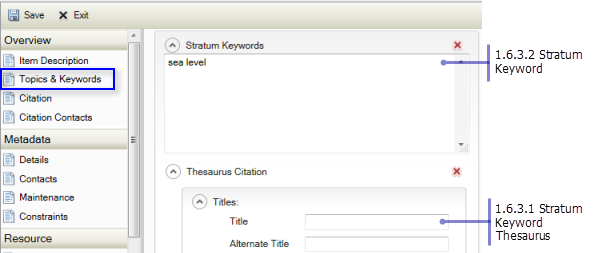
1.6.4 Temporal
| 1.6.4.1 | Temporal Keyword Thesaurus + |
| 1.6.4.2 | 1{Temporal Keyword}n |

1.9 Point of Contact

If a contact is provided in connection with the item's citation on the Overview > Citation Contacts page with the Point of Contact role, these will be exported to FGDC-format metadata as points of contact.
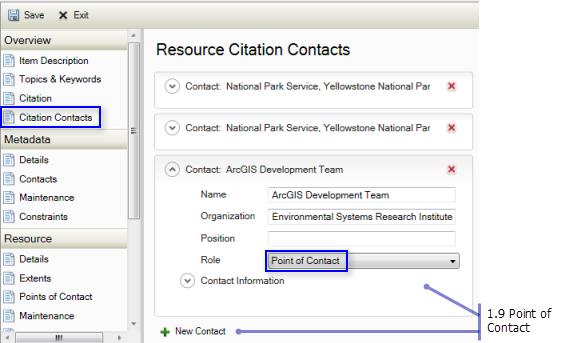
1.10 Browse Graphic
| 1.10.1 | Browse Graphic File Name + |
| 1.10.2 | Browse Graphic File Description + |
| 1.10.3 | Browse Graphic File Type |


1.12 Security Information
| 1.12.1 | Security Classification System + |
| 1.12.2 | Security Classification + |
| 1.12.3 | Security Handling Description |


1.14 Cross Reference
Citations for related resources are provided on the Resource > References page; they are referred to as aggregate resources. You must specify the type of association that exists between the item and the other resource. If you want to provide a Cross Reference for the item, be sure to select that option as the Association Type.

2 Data Quality Information
| 2.1 | 0{Attribute Accuracy}1 + |
| 2.2 | Logical Consistency Report + |
| 2.3 | Completeness Report + |
| 2.4 | 0{Positional Accuracy}1 + |
| 2.5 | Lineage + |
| 2.6 | (Cloud Cover) |
Describe the item's quality by providing different types of data quality reports. On the Resource > Quality page, choose the appropriate Report Type to identify the manner in which the item's quality is being assessed. The terminology used in ArcGIS metadata is a little different than the terminology used in the FGDC CSDGM, but the meanings are the same. To provide Logical Consistency information, provide Conceptual Consistency as the Report Type. For Completeness Report, provide Completeness Omission as the Report Type.



In ArcGIS metadata, cloud cover information is one of the details that can be provided to describe rasters that are images. This information is provided on the Resource > Content page in the Cloud Cover Percentage element.


2.1 Attribute Accuracy
| 2.1.1 | Attribute Accuracy Report + |
| 2.1.2 | (1{Quantitative Attribute Accuracy Assessment}n) |
To provide Attribute Accuracy information, select Quantitative Attribute Accuracy as the Report Type on the Resource > Quality page.

2.1.2 Quantitative Attribute Accuracy Assessment
| 2.1.2.1 | Attribute Accuracy Value + |
| 2.1.2.2 | Attribute Accuracy Explanation |
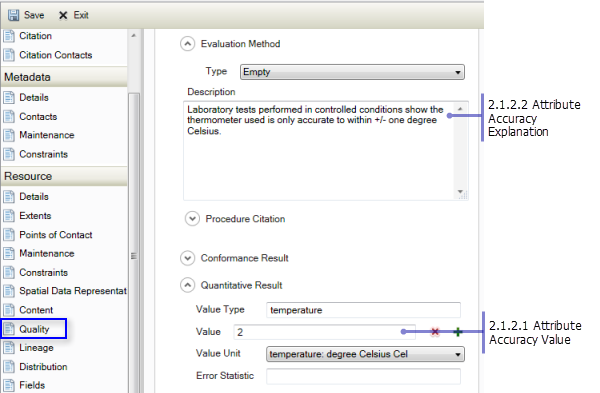
2.4 Positional Accuracy
| 2.4.1 | 0{Horizontal Positional Accuracy}1 + |
| 2.4.2 | 0{Vertical Positional Accuracy}1 |
To provide either Horizontal Positional Accuracy or Vertical Positional Accuracy information, select Absolute External Positional Accuracy as the Report Type on the Resource > Quality page.
2.4.1 Horizontal Positional Accuracy
| 2.4.1.1 | Horizontal Positional Accuracy Report + |
| 2.4.1.2 | (1{Quantitative Horizontal Positional Accuracy Assessment}n) |
For Horizontal Positional Accuracy information, select horizontal as the Dimension of data to which the quality report applies.

2.4.1.2 Quantitative Horizontal Positional Accuracy Assessment
| 2.4.1.2.1 | Horizontal Positional Accuracy Value + |
| 2.4.1.2.2 | Horizontal Positional Accuracy Explanation |
The ArcGIS metadata editor allows any type of value to be provided in the Value element. However, in the FGDC CSDGM, only Real numbers are allowed in this element.

2.4.2 Vertical Positional Accuracy
| 2.4.2.1 | Vertical Positional Accuracy Report + |
| 2.4.2.2 | (1{Quantitative Vertical Positional Accuracy Assessment}n) |
For Vertical Positional Accuracy information, select vertical as the Dimension of data to which the quality report applies.
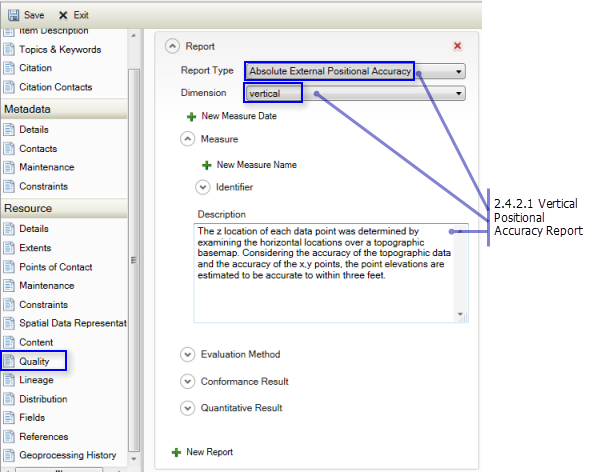
2.4.2.2 Quantitative Vertical Positional Accuracy Assessment
| 2.4.2.2.1 | Vertical Positional Accuracy Value + |
| 2.4.2.2.2 | Vertical Positional Accuracy Explanation |
The ArcGIS metadata editor allows any type of value to be provided in the Value element. However, in the FGDC CSDGM, only Real numbers are allowed in this element.

2.5 Lineage
| 2.5.1 | 0{Source Information}n + |
| 2.5.2 | 1{Process Step}n |

2.5.1 Source Information
| 2.5.1.1 | Source Citation + |
| 2.5.1.2 | 0{Source Scale Denominator}1 + |
| 2.5.1.3 | Type of Source Media + |
| 2.5.1.4 | Source Time Period of Content + |
| 2.5.1.5 | Source Citation Abbreviation + |
| 2.5.1.6 | Source Contribution |
When an item's existing FGDC metadata is upgraded or imported to ArcGIS, the phrases provided in the Type of Source Media element are converted to coded values. Check the value of the Medium Name element on the Resource > Lineage page to make sure its value was set appropriately.

2.5.1.1 Source Citation

2.5.1.4 Source Time Period of Content
| 2.5.1.4.1 | Source Currentness Reference |
To provide Source Time Period of Content information, add a Source Extent, then provide the appropriate dates and times associated with the resource.

2.5.2 Process Step
| 2.5.2.1 | Process Description + |
| 2.5.2.2 | 0{Source Used Citation Abbreviation}n + |
| 2.5.2.3 | Process Date + |
| 2.5.2.4 | (Process Time) + |
| 2.5.2.5 | 0{Source Produced Citation Abbreviation}n + |
| 2.5.2.6 | (Process Contact) |
Add a Data Source to a process step to identify the resources that were used in or produced by the operation that was performed.

To specify that the resource contributed information to the operation that was performed, select Used as the Source Type. A full citation for the resource can be provided in ArcGIS metadata. However, in the FGDC CSDGM standard, only an abbreviation is used to identify the resource—this is based on the assumption that the full citation is provided in the list of sources along with a corresponding abbreviation. The abbreviation is used as a shorthand for identifying the resource. Provide the abbreviation in the Source Citation > Alternate Title element.
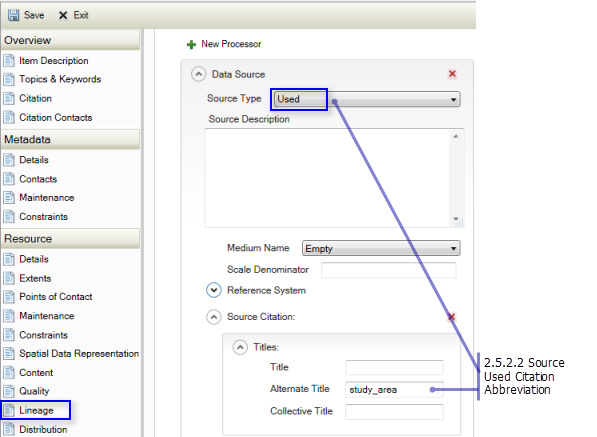
To specify that the resource was produced by the operation that was performed, select Produced as the Source Type. Sources that were produced are handled in the same manner as sources that were used by the operation. Provide the abbreviation that identifies the full citation for the resource that was produced in the Source Citation > Alternate Title element.

When geoprocessing tools are used to modify a resource, information about the operation is recorded in the item's geoprocessing history. You can include these operations in the item's official lineage, if it is appropriate to do so. On the Resource > Geoprocessing History page, check Export; when metadata is exported to an FGDC-format XML file the identified steps will be incorporated into the item's lineage.

2.5.2.6 Process Contact

3 Spatial Data Organization Information
| 3.1 | 0{Indirect Spatial Reference}1 + |
| 3.2 | 0{Direct Spatial Reference Method + |
| 3.3 | ( [Point and Vector Object Information | |
| 3.4 | Raster Object Information] )}1 |
All rasters that are managed using ArcGIS should be described by providing information on the Resource > Spatial Data Representation page under the Georectified Representation heading.


The type of digital spatial data that an item contains is described using the Spatial Representation Type element on the Resource > Details page, if appropriate. When an item's metadata is exported to an FGDC-format XML file, the value Vector is exported in the Direct Spatial Reference Method element for all types of vector data including point and multipoint datasets; in ArcGIS, all vector data is handled in the same manner regardless of the geometry type that is used to represent features. The value Raster is exported in the same element for all types of rasters.

3.3 Point and Vector Object Information
| 3.3.1 | [1{SDTS Terms Description}n | |
| 3.3.2 | VPF Terms Description] |
ArcGIS automatically synchronizes the properties of a vector dataset that can be recorded in the item's metadata with the item's actual properties. These properties are recorded in the same manner for all vector data formats. The dataset's properties are recorded in two separate locations. In one location, the ISO 19115 codelist is used to describe the type of features stored in the dataset; this list is based on GML geometry types and provides a very general classification. This information can be edited. In another location, internal ArcGIS terminology is used, and ArcGIS-specific properties are recorded; this information can't be edited.
In general, there should be no need to modify the synchronized information. However, it may be necessary to provide this information manually for some resources where ArcGIS is unable to synchronize these properties. This information can be edited on the Resource > Spatial Data Representation page under the Vector Representation heading. If you modify any synchronized values, ArcGIS will no longer update those properties when the data changes. The ArcGIS-specific properties section will always be synchronized with the item's current properties.
When an item's metadata is exported to an FGDC-format XML file, preference is given to the synchronized properties that use ArcGIS-specific terminology, if they exist. Not only are the properties guaranteed to be current, but with the ArcGIS feature type and geometry type values the most appropriate FGDC CSDGM Object Type for the item can be selected. If the ArcGIS-specific terminology section is unavailable, the Vector Representation information will be used instead. However, the ISO 19115 object type codelist doesn't correspond well to the highly detailed FGDC CSDGM SDTS Point and Vector Object Type list of values; the exported value may not be the best one to use for your dataset.

3.3.1 SDTS Terms Description
| 3.3.1.1 | SDTS Point and Vector Object Type + |
| 3.3.1.2 | (Point and Vector Object Count) |


3.3.2 VPF Terms Description
| 3.3.2.1 | VPF Topology Level + |
| 3.3.2.2 | 1{VPF Point and Vector Object Information}n |
Metadata describing VPF-format vector data is provided in the same manner as for other vector data formats.

3.3.2.2 VPF Point and Vector Object Information
| 3.3.2.2.1 | VPF Point and Vector Object Type + |
| 3.3.2.2.2 | (Point and Vector Object Count) |

3.4 Raster Object Information
| 3.4.1 | Raster Object Type + |
| 3.4.2 | (Row Count + |
| 3.4.3 | Column Count + |
| 3.4.4 | 0{Vertical Count}1 ) |
ArcGIS automatically synchronizes a raster's metadata with the properties of the raster dataset itself. The properties that are associated with FGDC CSDGM metadata are only recorded in one location and can be edited. Additional properties that describe the raster using ArcGIS-specific terminology are updated automatically for the item and can't be edited.
In general, there should be no need to modify the synchronized information. However, it may be necessary to provide this information manually for some resources where ArcGIS is unable to synchronize these properties. This information can be edited on the Resource > Spatial Data Representation page under the Georectified Representation heading. If you modify any synchronized values, ArcGIS will no longer update those properties when the data changes.

The type of object used by a raster to identify a location is described using the Cell Geometry element on the Resource > Spatial Data Representation page under the Georectified Representation heading. In ArcGIS, all raster cells are handled as areas. Other values are available to describe resources not managed by ArcGIS.
While ArcGIS handles all rasters in the same manner regardless of the type of data they contain, the FGDC CSDGM standard suggests using different values in the Raster Object Type element for imagery than for other raster data. When an item's metadata is exported to an FGDC-format XML file, values in both the Cell Geometry element and the Content Type element on the Resource > Content page will be considered to determine the appropriate value for the FGDC Raster Object Type element.


To specify a raster's size, add a Dimension under the Georectified Representation heading on the Resource > Spatial Data Representation page. The Name element identifies the dimension of data that is being described. Specify the appropriate number of cells along that axis using the Size element.


4 Spatial Reference Information
| 4.1 | 0{Horizontal Coordinate System Definition}1 + |
| 4.2 | 0{Vertical Coordinate System Definition}1 |
ArcGIS automatically synchronizes the item's spatial reference in its metadata if this information has been set in the item itself. Full details of the spatial reference are recorded in an ArcGIS-specific format. This information can't be edited. Detailed spatial reference properties as defined in the FGDC CSDGM can't be provided manually with the current version of ArcGIS. In general, there should be no need to modify the synchronized information. When an item's metadata is exported to an FGDC-format XML file, the synchronized properties of the spatial reference are extracted and formatted correctly according to the FGDC CSDGM, if they exist.
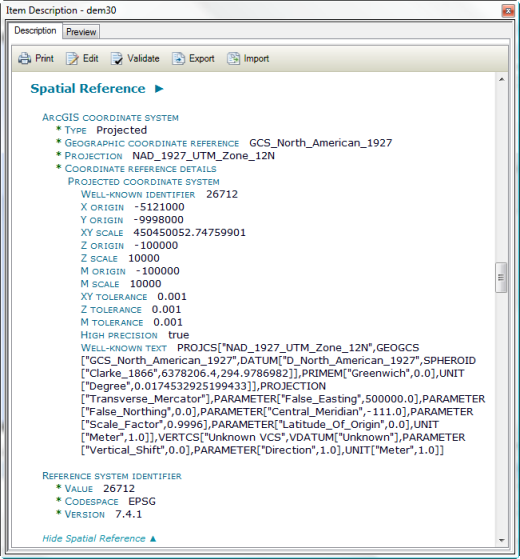
5 Entity and Attribute Information
| 5.1 | [1{Detailed Description}n | |
| 5.2 | 1{Overview Description}n | |
| 1{Detailed Description}n + | |
| 1{Overview Description}n] |

5.1 Detailed Description
| 5.1.1 | Entity Type + |
| 5.1.2 | 0{Attribute}n |
ArcGIS automatically maintains information about the item's attributes through the synchronization process. Attributes are added to the metadata if a field hasn't already been recorded in the metadata. If the item's metadata includes an attribute whose label doesn't match the name of a field in the data, it will be removed from the item's metadata. In general, there should be no need to add or remove attributes.

5.1.1 Entity Type
| 5.1.1.1 | Entity Type Label + |
| 5.1.1.2 | Entity Type Definition + |
| 5.1.1.3 | Entity Type Definition Source |
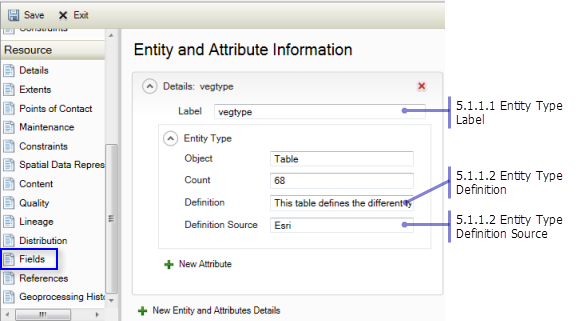
5.1.2 Attribute
| 5.1.2.1 | Attribute Label + |
| 5.1.2.2 | Attribute Definition + |
| 5.1.2.3 | Attribute Definition Source + |
| 5.1.2.4 | 1{Attribute Domain Values}n + |
| 5.1.2.5 | 0{Beginning Date of Attribute Values + |
| 5.1.2.6 | 0{Ending Date of Attribute Values}1}n + |
| 5.1.2.7 | (Attribute Value Accuracy Information) + |
| 5.1.2.8 | (Attribute Measurement Frequency) |
When an item's existing FGDC metadata is upgraded or imported to ArcGIS, the phrase provided in the Attribute Measurement Frequency element is converted to a coded value, if possible. Check the value of the Value Measurement Frequency element on the Resource > Fields page under each Attribute heading to make sure the value was set appropriately.
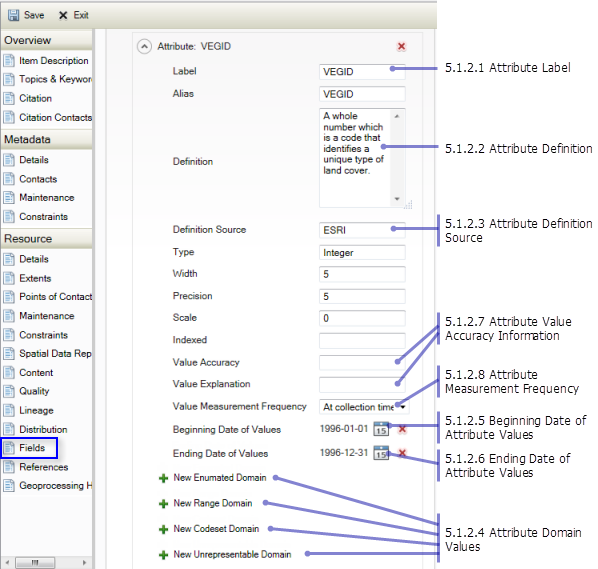
5.1.2.4 Attribute Domain Values
| 5.1.2.4.1 | [Enumerated Domain | |
| 5.1.2.4.2 | Range Domain | |
| 5.1.2.4.3 | Codeset Domain | |
| 5.1.2.4.4 | Unrepresentable Domain] |

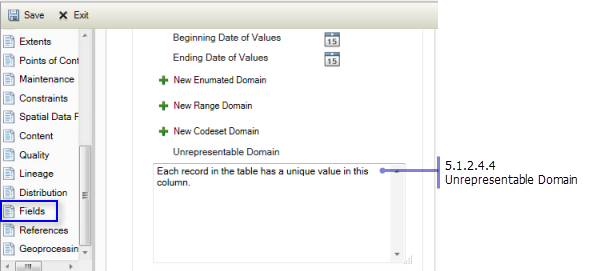
5.1.2.4.1 Enumerated Domain
| 5.1.2.4.1.1 | 1{Enumerated Domain Value + |
| 5.1.2.4.1.2 | Enumerated Domain Value Definition + |
| 5.1.2.4.1.3 | Enumerated Domain Value Definition Source + |
| 5.1.2.4.1.4 | 0{Attribute}n }n |
The secondary Attribute element that is allowed in the FGDC CSDGM in association with an Enumerated Domain can't be described in ArcGIS.
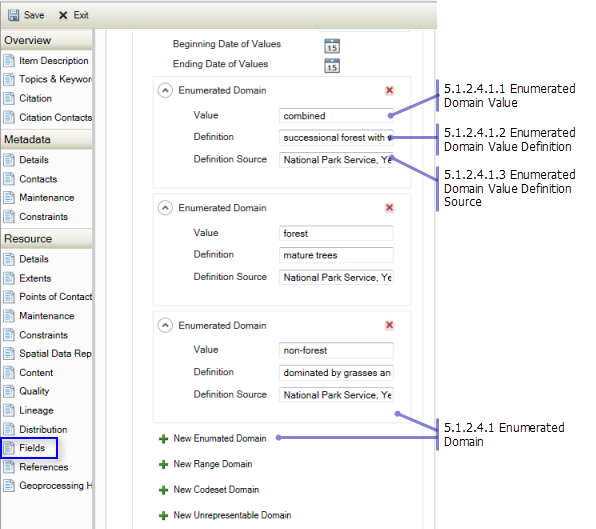
5.1.2.4.2 Range Domain
| 5.1.2.4.2.1 | Range Domain Minimum + |
| 5.1.2.4.2.2 | Range Domain Maximum + |
| 5.1.2.4.2.3 | 0{Attribute Units of Measure}1 + |
| 5.1.2.4.2.4 | (Attribute Measurement Resolution) + |
| 5.1.2.4.2.5 | 0{Attribute}n |

The secondary Attribute element that is allowed in the FGDC CSDGM in association with a Range Domain can't be described in ArcGIS.

5.1.2.4.3 Codeset Domain
| 5.1.2.4.3.1 | Codeset Name + |
| 5.1.2.4.3.2 | Codeset Source |


5.1.2.7 Attribute Value Accuracy Information
| 5.1.2.7.1 | Attribute Value Accuracy + |
| 5.1.2.7.2 | Attribute Value Accuracy Explanation |

5.2 Overview Description
| 5.2.1 | Entity and Attribute Overview + |
| 5.2.2 | 1{Entity and Attribute Detail Citation}n |
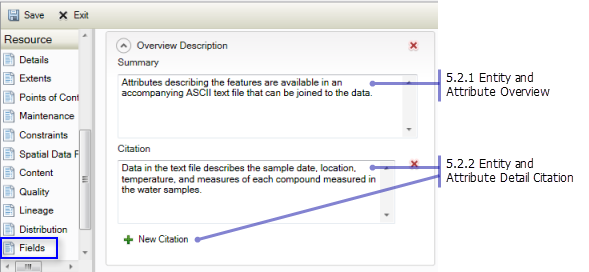
6 Distribution Information
| 6.1 | Distributor + |
| 6.2 | 0{Resource Description}1 + |
| 6.3 | Distribution Liability + |
| 6.4 | 0{Standard Order Process}n + |
| 6.5 | 0{Custom Order Process}1 + |
| 6.6 | (Technical Prerequisites) + |
| 6.7 | (Available Time Period) |
For FGDC metadata, all distribution information must be provided in connection with a specific Distributor on the Resource > Distribution page. When metadata is exported to an FGDC-format XML file, information under the Distribution Format and Digital Transfer Options headings at the top level of the Distribution page will not be included.

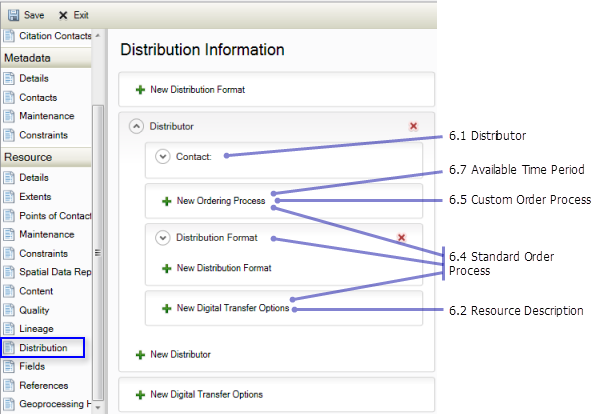
In ArcGIS metadata, resource descriptions are provided in connection with digital methods of distributing the resource on the Resource > Distribution page under a specific Distributor's Digital Transfer Options heading. Many online locations can be provided for accessing the resource, with each location under its own Online Resource heading and with its own Description. The first description found that is not an ArcIMS Metadata Service Content Type will be exported to the FGDC Resource Description element.

The FGDC Distribution Liability information is a legal statement provided in connection with the resource. In ArcGIS metadata, this information is provided with the other Legal Constraints on the Resource > Constraints page in the Use Limitation element.


In ArcGIS metadata, Custom Order Process instructions and Standard Order Process Ordering Instructions are handled in the same manner. On the Resource > Distribution page under a specific Distributor's Ordering Process heading, put this information into the Ordering Instructions element. This information is often available on the Internet and very likely will change more often than an item's metadata. Consider directing people to the appropriate web page to get more information about how the resource can be ordered.

Information that corresponds with the FGDC Technical Prerequisites element will be upgraded or imported to ArcGIS metadata. However, at present, technical prerequisites can't be edited in the pestaña Descripción.
6.1 Distributor
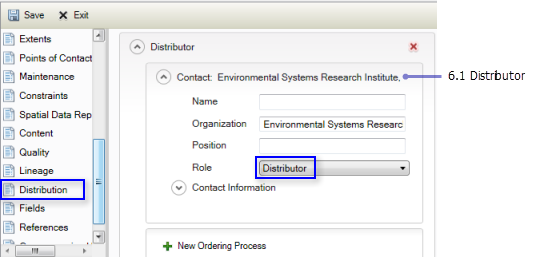
6.4 Standard Order Process
| 6.4.1 | [Non-digital Form | |
| 6.4.2 | 1{Digital Form}n ] + |
| 6.4.3 | Fees + |
| 6.4.4 | (Ordering Instructions) + |
| 6.4.5 | (Turnaround) |
In ArcGIS metadata, Non-digital Form information is handled in the same manner as digital information that is provided offline using some form of media. One of many hard-copy medium codes identifies the resource as being non-digital. Provide details about this non-digital distribution medium in the Medium Note element on the Resource > Distribution page under a specific Distributor's Digital Transfer Options heading.
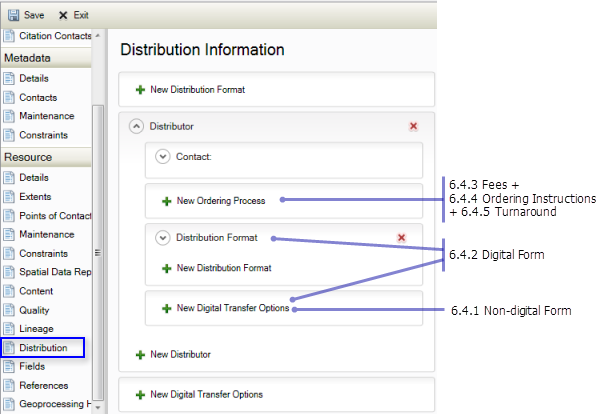
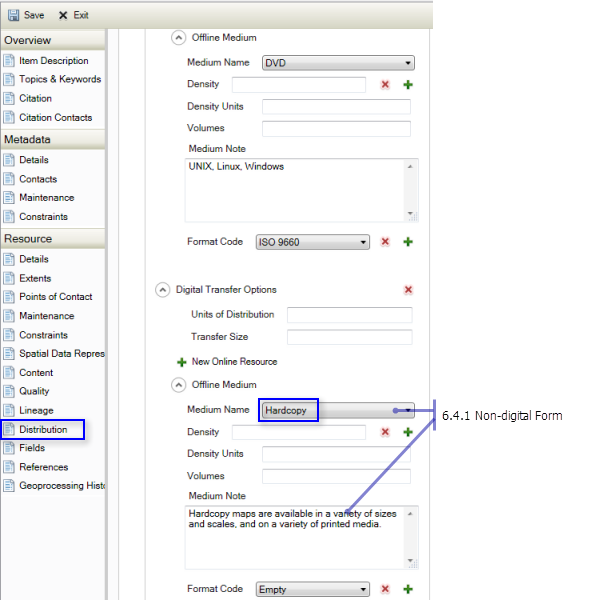

6.4.2 Digital Form
| 6.4.2.1 | Digital Transfer Information + |
| 6.4.2.2 | Digital Transfer Option |
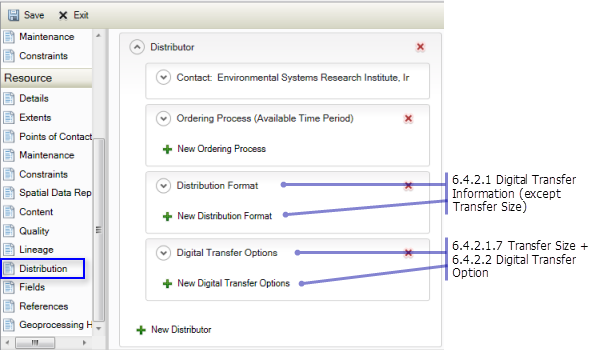
6.4.2.1 Digital Transfer Information
| 6.4.2.1.1 | Format Name + |
| 6.4.2.1.2 | ([Format Version Number | |
| 6.4.2.1.3 | Format Version Date] + |
| 6.4.2.1.4 | (Format Specification) ) + |
| 6.4.2.1.5 | (Format Information Content) + |
| 6.4.2.1.6 | 0{File Decompression Technique}1 + |
| 6.4.2.1.7 | (Transfer Size) |


6.4.2.2 Digital Transfer Option
| 6.4.2.2.1 | 1{ [Online Option | |
| 6.4.2.2.2 | Offline Option] }n |
Digital methods of distributing the resource are provided on the Resource > Distribution page under a specific Distributor's Digital Transfer Options heading. Many online locations can be provided for accessing the resource, with each location under its own Online Resource heading.
Only one Offline Medium can be described under each Digital Transfer Options heading. To describe an additional medium on which the resource can be provided, add another Digital Transfer Options heading. If information about obtaining the resource on different media is available on the Internet, consider providing a link to this information in the ordering instructions rather than repeating it all in the item's metadata. The available media are likely to change more often than the item's metadata.

6.4.2.2.1 Online Option
| 6.4.2.2.1.1 | 1{Computer Contact Information}n + |
| 6.4.2.2.1.2 | (Access Instructions) + |
| 6.4.2.2.1.3 | (Online Computer and Operating System) |

Information associated with the FGDC CSDGM Online Computer and Operating System elements can't be provided in ArcGIS metadata.
6.4.2.2.1.1 Computer Contact Information
| 6.4.2.2.1.1.1 | [Network Address | |
| 6.4.2.2.1.1.2 | Dialup Instructions] |

Dialup Instructions can't be provided in an item's metadata using ArcGIS. If existing metadata includes this information it should be updated to include current information by which the item can be obtained.
6.4.2.2.1.1.1 Network Address
| 6.4.2.2.1.1.1.1 | 1{Network Resource Name}n |

6.4.2.2.2 Offline Option
| 6.4.2.2.2.1 | Offline Media + |
| 6.4.2.2.2.2 | 0{Recording Capacity}1 |
| 6.4.2.2.2.3 | 1{Recording Format}n + |
| 6.4.2.2.2.4 | 0{Compatibility Information}1 |

6.4.2.2.2.2 Recording Capacity
| 6.4.2.2.2.2.1 | 1{Recording Density}n + |
| 6.4.2.2.2.2.2 | Recording Density Units |

6.7 Available Time Period
In ArcGIS, you can only provide a single date or a date range when the item will be available.

7 Metadata Reference Information
| 7.1 | Metadata Date + |
| 7.2 | (Metadata Review Date) + |
| 7.3 | (Metadata Future Review Date) + |
| 7.4 | Metadata Contact + |
| 7.5 | Metadata Standard Name + |
| 7.6 | Metadata Standard Version + |
| 7.7 | 0{Metadata Time Convention}1 + |
| 7.8 | (Metadata Access Constraints) + |
| 7.9 | (Metadata Use Constraints) + |
| 7.10 | (Metadata Security Information) + |
| 7.11 | 0{Metadata Extensions}n |
The date of an item's metadata is automatically updated by ArcGIS when it is synchronized and when edits are saved. However, if the metadata was authored at another time and you are merely transcribing or upgrading the metadata you may want to provide that date instead. Once the metadata date has been changed manually it won't be updated by ArcGIS when the item's metadata is synchronized or when future edits are saved. You will always have to manually change the date using the Date Stamp element on the Metadata > Details page.

Record the date when the metadata was last reviewed in the Maintenance Note element on the Metadata > Maintenance page. Specify the phrase Last metadata review date: , followed by the date in the FGDC date format: yyyymmdd. When the item's metadata is exported to an FGDC-format XML file, the date following the phrase will be extracted and stored in the FGDC Metadata Review Date element.




In ArcGIS, the metadata standard or profile that is being adhered to is determined by the metadata style that has been selected. Therefore, you can't provide content for the Metadata Standard Name and Metadata Standard Version elements in the pestaña Descripción. When ArcGIS metadata is exported to an FGDC-format XML file, these elements are added automatically by the ArcGIS to FGDC translator with the appropriate values for that style.
In ArcGIS, all dates and times in the item's metadata are collected based on the current local time. Content can't be provided for the Metadata Time Convention element because its value is determined by the ArcGIS metadata editor itself. When ArcGIS metadata is exported to an FGDC-format XML file, this element is added automatically by the ArcGIS to FGDC translator with the appropriate value to avoid any ambiguity regarding the nature of the dates and times recorded in the item's metadata.
7.4 Metadata Contact

7.10 Metadata Security Information
| 7.10.1 | Metadata Security Classification System + |
| 7.10.2 | Metadata Security Classification + |
| 7.10.3 | Metadata Security Handling Description |

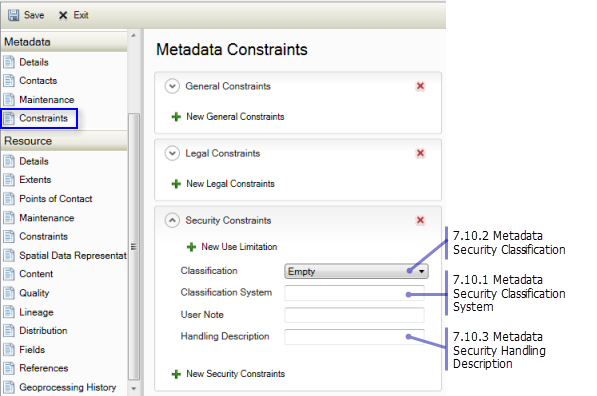
7.11 Metadata Extensions
| 7.11.1 | 0{Online Linkage}n + |
| 7.11.2 | 0{Profile Name}1 |
Metadata Extension information can't be edited in ArcGIS. To properly support a metadata extension or profile in ArcGIS, a custom version of the ArcGIS metadata editor must be created using the ArcGIS Metadata Toolkit. The custom editor must be accompanied by a custom metadata style that can be selected in the Options dialog box. If extended information is supported by the custom editor, it must be accompanied by an importer that knows how to handle that information when metadata is imported. It must also be accompanied by an exporter that knows how to handle custom content stored in ArcGIS metadata and format it correctly in the exported XML file to satisfy the extension or profile. The exporter must detect the custom metadata style and automatically add the appropriate Metadata Standard Name, Metadata Standard Version, and Metadata Extension information associated with that style in the exported metadata XML file.
8 Citation Information
| 8.1 | 1{Originator}n + |
| 8.2 | Publication Date + |
| 8.3 | (Publication Time) + |
| 8.4 | Title + |
| 8.5 | 0{Edition}1 + |
| 8.6 | 0{Geospatial Data Presentation Form}1 + |
| 8.7 | 0{Series Information}1 + |
| 8.8 | 0{Publication Information}1 + |
| 8.9 | 0{Other Citation Details}1 + |
| 8.10 | (1{Online Linkage}n) + |
| 8.11 | 0{Larger Work Citation}1 |
In ArcGIS metadata, the citation for the item itself is handled differently than for other resources that may be cited in the item's metadata, such as sources for a given process or cross-referenced resources. Only a brief citation can be provided for other cited resources in the item's metadata. To learn more about the cited resource, locate and read its metadata.

For cited resources in an item's metadata, the FGDC CSDGM Geospatial Data Presentation Form element is associated with two ArcGIS metadata elements. The Presentation Form element on the Overview > Citation page offers a good overall categorization of the type of information provided by the item.
When existing FGDC-formatted metadata is upgraded or imported, the original Geospatial Data Presentation Form value is kept in the ArcGIS Metadata element FGDC Geospatial Data Presentation Form. For new ArcGIS metadata you can also select a value from the FGDC CSDGM Geospatial Data Presentation Form domain using this element on the Overview > Citation page. This element's domain might let you describe different types of hard-copy maps better than the codelists used by the other ArcGIS metadata elements. Setting a value in this ArcGIS element doesn't alter any FGDC-formatted content that may also exist in the item's metadata.
When ArcGIS metadata is exported to an FGDC-format XML file, both of these elements are considered when determining the most appropriate value to place in the Geospatial Data Presentation Form element. This information is handled differently for the item's own citation; see the Identification Information section for details.


In ArcGIS metadata, an Originator is a contact associated with the citation. The contact's role identifies how that contact is associated with the resource. For resources that are cited in the item's metadata, these contacts are provided by clicking New Contact under the Citation heading; you can find it between the Series heading and the Other Details element. Set the contact's role to originator. For information about how to provide this information for the item's own citation, see the Identification Information section.
The contact may be identified in ArcGIS metadata by the name of the individual, the organization, or the position associated with the resource. For originators, all of these values that are provided will be combined into one Originator entry, separated by commas, when the item's metadata is exported to the FGDC XML format.

In ArcGIS metadata, an Online Linkage is provided differently for the item itself than for citations that describe other related resources. For information about how to provide this information for the item's own citation, see the Identification Information section.
8.7 Series Information
| 8.7.1 | Series Name + |
| 8.7.2 | Issue Identification |

8.8 Publication Information
| 8.8.1 | Publication Place + |
| 8.8.2 | Publisher |
In ArcGIS metadata, an Publisher is a contact associated with the citation. The contact's role identifies how that contact is associated with the resource. For resources that are cited in the item's metadata, these contacts are provided by clicking New Contact under the Citation heading; you can find it between the Series heading and the Other Details element. Set the contact's role to publisher. For information about how to provide this information for the item's own citation, see the Identification Information section.
The contact may be identified in ArcGIS metadata by the name of the individual, the organization, or the position associated with the resource. For publishers, if an Organization is provided, that value will be used to identify the publisher when the item's metadata is exported to the FGDC XML format. If there is no Organization but an Individual has been provided, the Individual will be exported as the publisher. If only a Position has been specified, this value will be used to identify the publisher.
Any values that have been provided in the Address, City, State, Postal Code, and Country elements will be combined, separated by commas, and exported as the FGDC Publication Place element.

8.11 Larger Work Citation
In ArcGIS metadata, a Larger Work Citation can only be provided for the item itself. Only a brief citation can be provided for other cited resources in the item's metadata. To learn more about a cited resource, such as any larger works with which it is associated, locate and read its metadata. For information about how to provide this information for the item's own citation, see the Identification Information section.
9 Time Period Information
| 9.1 | [Single Date/Time | |
| 9.2 | Multiple Dates/Times | |
| 9.3 | Range of Dates/Times ] |
All dates and times are set in the same manner in ArcGIS metadata, as illustrated below.
9.1 + 9.2.1 Single Date/Time
| 9.1.1 + 9.2.1.1 | Calendar Date + |
| 9.1.2 + 9.2.1.2 | (Time of Day) |
Click the Calendar icon to select a date.

The calendar appears showing today's date, shaded gray.

In the calendar, you can scroll through the months using the arrows at the top, or click the month and year to pick from a list of months.

Click the year at the top of the calendar to pick from a list of years.

After clicking the appropriate year, the list of months will be displayed. If you previously selected a month it will still be selected; otherwise, the current month will be selected. After clicking the appropriate month, the list of days will be displayed. After clicking the appropriate day, the specified date appears on the page.

To provide a time, the hours, minutes, and seconds must be specified separately. To set the hour, either click the up and down arrows, or click the hour and type the appropriate number. Hours are recorded based on the 24-hour clock.

To set the minutes and seconds, click that portion of the time and type the appropriate number.

9.2 Multiple Dates/Times
| 9.2.1 | 2{Single Date/Time}n |

9.3 Range of Dates/Times
| 9.3.1 | Beginning Date + |
| 9.3.2 | (Beginning Time) + |
| 9.3.3 | Ending Date + |
| 9.3.4 | (Ending Time) |

10 Contact Information
| 10.1 | [Contact Person Primary | |
| 10.2 | Contact Organization Primary] + |
| 10.3 | (Contact Position) + |
| 10.4 | 1{Contact Address}n + |
| 10.5 | 1{Contact Voice Telephone}n + |
| 10.6 | (1{Contact TDD/TTY Telephone}n) + |
| 10.7 | (1{Contact Facsimile Telephone}n) + |
| 10.8 | (1{Contact Electronic Mail Address}n) + |
| 10.9 | (Hours of Service) + |
| 10.10 | (Contact Instructions) |
Over time, more work is required to update outdated contact information than most of the other content in an item's metadata. When providing contact information, consider the longevity of the information.
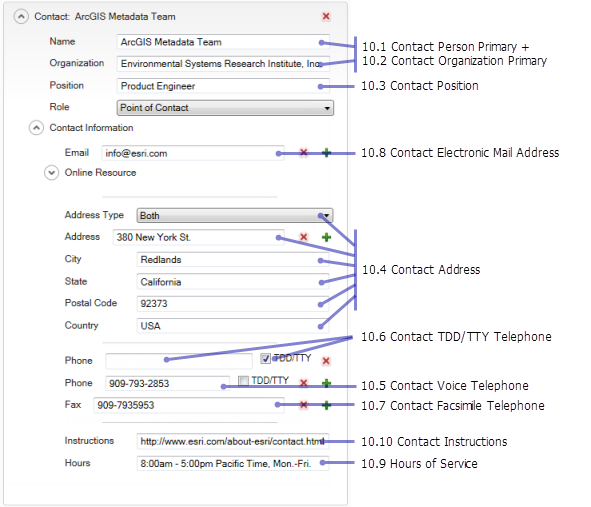
10.1 Contact Person Primary
| 10.1.1 | Contact Person + |
| 10.1.2 | (Contact Organization) |
In ArcGIS metadata you can't specify if the person or the organization is the primary point of contact. If only an individual's name has been provided, that person will be considered the primary contact. If a person is truly the primary contact for the item, then the organization to which the person belongs doesn't matter. The person's affiliation is likely to change over time.

10.2 Contact Organization Primary
| 10.2.1 | Contact Organization + |
| 10.2.2 | (Contact Person) |
In ArcGIS metadata you can't specify if the person or the organization is the primary point of contact. Generally speaking, the organization is always the primary contact. If an organization name has been provided it will always be considered the primary contact when the item's metadata is exported to an FGDC-format XML file.

10.4 Contact Address
| 10.4.1 | Address Type + |
| 10.4.2 | 0{Address}n + |
| 10.4.3 | City + |
| 10.4.4 | State or Province + |
| 10.4.5 | Postal Code + |
| 10.4.6 | (Country) |
In ArcGIS metadata, only one address can be provided for a contact.

Temas relacionados
- El formato de metadatos de ArcGIS
- Diferencias entre metadatos de ArcGIS y de FGDC
- Estándares y estilos de metadatos
- Crear metadatos que cumplan con el estándar
- Un recorrido rápido por la creación y edición de metadatos
- Editar metadatos
- Crear y administrar metadatos FGDC
- Actualizar metadatos
- Acerca de la visualización de metadatos
- Un recorrido rápido por la publicación de metadatos
- Un recorrido rápido por la importación y la exportación de metadatos
- Importar metadatos mediante herramientas de geoprocesamiento
- Exportar metadatos mediante herramientas de geoprocesamiento